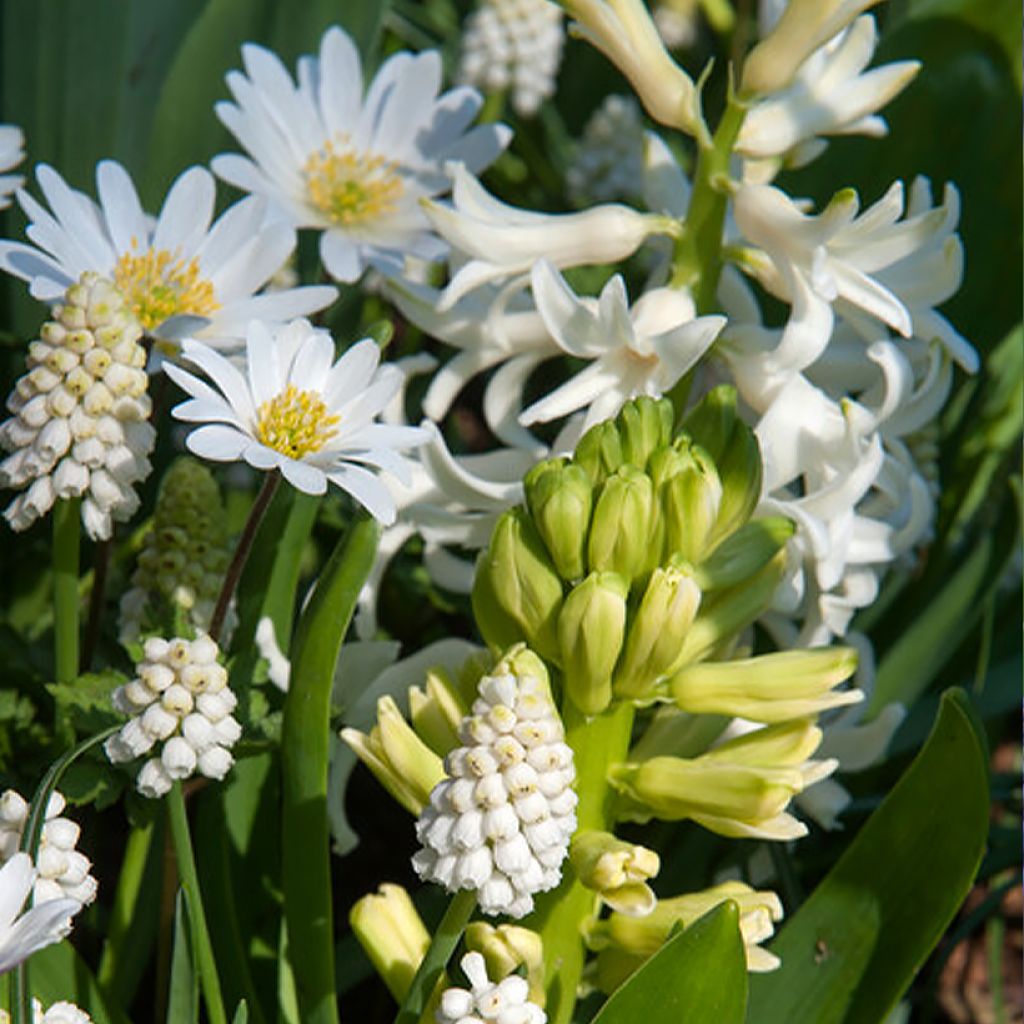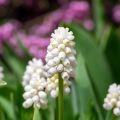

Inspiration collection of 40 small, white spring-flowering bulbs
Inspiration collection of 40 small, white spring-flowering bulbs
Anemone, Muscari, Hyacinthus
This plant carries a 6 months recovery warranty
More information
We guarantee the quality of our plants for a full growing cycle, and will replace at our expense any plant that fails to recover under normal climatic and planting conditions.
From €5.90 for pickup delivery and €6.90 for home delivery
Express home delivery from €8.90.
Does this plant fit my garden?
Set up your Plantfit profile →
Collection items (40 plants)
Description
This Inspiration collection of small spring bulbs with white flowers brings together 40 spring-flowering bulbs. The small daisy-like flowers of the Greek anemone mix with the clusters of muscari and the sweet spikes of the hyacinth. These easy-to-grow small bulbs form low and flowering carpets from the first warm days, between March and May, faithfully return each year and multiply spontaneously over the years. An elegant and bright touch for borders, rockeries, and planters! Plant in partial shade or in the sun, in ordinary but well-drained soil.
This Inspiration collection consists of:
x 15 Anemone blanda 'White Splendour': its delicate foliage somewhat resembles parsley, it is dark green, finely cut, and strongly toothed. It sometimes appears as early as March, depending on the climate, at the same time as the flowers fade, then disappears in autumn, sometimes in the middle of summer if the soil is dry.
x 20 Muscari aucheri 'White Magic': a horticultural variety, rarer than the blue form, producing small clusters of pure white, fragrant pearls before the appearance of foliage. The foliage dries out some time after flowering, then disappears.
x 5 Hyacinthus orientalis 'Carnegie': one of the whitest varieties, but also one of the most deliciously fragrant. Each bulb produces a dense spike filled with sweetly scented flowers, between late March and early May, very noticeable when the flower is warmed by the sun's rays. Its flowers last for 3 weeks in the ground, and up to 2 weeks in a vase!
The plants are labelled separately.
Plant the tubers of the anemones and the bulbs of the muscari and hyacinths in large groups, mixing them along the edge of a lawn, at the base of hedges, in a rockery, or under deciduous bushes. You can also create beautiful planters with this collection. The essential thing is that the plants receive sunlight in spring. A light shade is not harmful to flowering since bulbs are dormant at this time of year. Perfectly hardy, these plants are easy to grow in moderately moist soils and well-suited to dry soils in summer, even rocky ones.
These white flowers work wonders under trees and shrubs with spring flowering, especially under Ornamental Crabapple Trees, Flowering Cherry Trees, and Star Magnolias.
Report an error about the product description
Plant habit
Flowering
Foliage
Botanical data
Anemone, Muscari, Hyacinthus
Cultivar or hybrid
Planting and care
Plant your bulbs and tubers as soon as possible in well-drained soil that does not retain excess water. Loosen the soil deeply, mix in some compost and gravel if your soil is very clayey and heavy. Bulbs should be covered with soil to a depth twice their height. Space the bulbs apart, making sure they do not touch. Choose a sunny location (sun is essential in spring) or a partially shaded one (light shade is acceptable in summer). In hot climates, choose partial shade or plant at the base of deciduous bushes and trees.
Planting period
Intended location
Care
This item has not been reviewed yet - be the first to leave a review about it.
Haven't found what you were looking for?
Hardiness is the lowest winter temperature a plant can endure without suffering serious damage or even dying. However, hardiness is affected by location (a sheltered area, such as a patio), protection (winter cover) and soil type (hardiness is improved by well-drained soil).

Photo Sharing Terms & Conditions
In order to encourage gardeners to interact and share their experiences, Promesse de fleurs offers various media enabling content to be uploaded onto its Site - in particular via the ‘Photo sharing’ module.
The User agrees to refrain from:
- Posting any content that is illegal, prejudicial, insulting, racist, inciteful to hatred, revisionist, contrary to public decency, that infringes on privacy or on the privacy rights of third parties, in particular the publicity rights of persons and goods, intellectual property rights, or the right to privacy.
- Submitting content on behalf of a third party;
- Impersonate the identity of a third party and/or publish any personal information about a third party;
In general, the User undertakes to refrain from any unethical behaviour.
All Content (in particular text, comments, files, images, photos, videos, creative works, etc.), which may be subject to property or intellectual property rights, image or other private rights, shall remain the property of the User, subject to the limited rights granted by the terms of the licence granted by Promesse de fleurs as stated below. Users are at liberty to publish or not to publish such Content on the Site, notably via the ‘Photo Sharing’ facility, and accept that this Content shall be made public and freely accessible, notably on the Internet.
Users further acknowledge, undertake to have ,and guarantee that they hold all necessary rights and permissions to publish such material on the Site, in particular with regard to the legislation in force pertaining to any privacy, property, intellectual property, image, or contractual rights, or rights of any other nature. By publishing such Content on the Site, Users acknowledge accepting full liability as publishers of the Content within the meaning of the law, and grant Promesse de fleurs, free of charge, an inclusive, worldwide licence for the said Content for the entire duration of its publication, including all reproduction, representation, up/downloading, displaying, performing, transmission, and storage rights.
Users also grant permission for their name to be linked to the Content and accept that this link may not always be made available.
By engaging in posting material, Users consent to their Content becoming automatically accessible on the Internet, in particular on other sites and/or blogs and/or web pages of the Promesse de fleurs site, including in particular social pages and the Promesse de fleurs catalogue.
Users may secure the removal of entrusted content free of charge by issuing a simple request via our contact form.
The flowering period indicated on our website applies to countries and regions located in USDA zone 8 (France, the United Kingdom, Ireland, the Netherlands, etc.)
It will vary according to where you live:
- In zones 9 to 10 (Italy, Spain, Greece, etc.), flowering will occur about 2 to 4 weeks earlier.
- In zones 6 to 7 (Germany, Poland, Slovenia, and lower mountainous regions), flowering will be delayed by 2 to 3 weeks.
- In zone 5 (Central Europe, Scandinavia), blooming will be delayed by 3 to 5 weeks.
In temperate climates, pruning of spring-flowering shrubs (forsythia, spireas, etc.) should be done just after flowering.
Pruning of summer-flowering shrubs (Indian Lilac, Perovskia, etc.) can be done in winter or spring.
In cold regions as well as with frost-sensitive plants, avoid pruning too early when severe frosts may still occur.
The planting period indicated on our website applies to countries and regions located in USDA zone 8 (France, United Kingdom, Ireland, Netherlands).
It will vary according to where you live:
- In Mediterranean zones (Marseille, Madrid, Milan, etc.), autumn and winter are the best planting periods.
- In continental zones (Strasbourg, Munich, Vienna, etc.), delay planting by 2 to 3 weeks in spring and bring it forward by 2 to 4 weeks in autumn.
- In mountainous regions (the Alps, Pyrenees, Carpathians, etc.), it is best to plant in late spring (May-June) or late summer (August-September).
The harvesting period indicated on our website applies to countries and regions in USDA zone 8 (France, England, Ireland, the Netherlands).
In colder areas (Scandinavia, Poland, Austria...) fruit and vegetable harvests are likely to be delayed by 3-4 weeks.
In warmer areas (Italy, Spain, Greece, etc.), harvesting will probably take place earlier, depending on weather conditions.
The sowing periods indicated on our website apply to countries and regions within USDA Zone 8 (France, UK, Ireland, Netherlands).
In colder areas (Scandinavia, Poland, Austria...), delay any outdoor sowing by 3-4 weeks, or sow under glass.
In warmer climes (Italy, Spain, Greece, etc.), bring outdoor sowing forward by a few weeks.




































